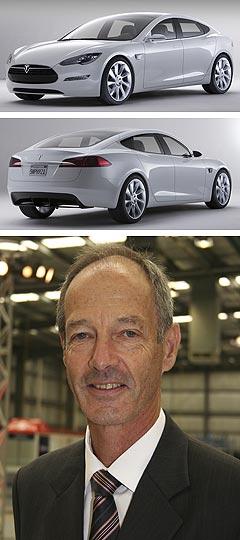Electric Commodore to get Tesla-style rear motor
BY RON HAMMERTON | 21st Feb 2011

The arrangement effectively reverses the traditional Australian large car layout of engine in the front and fuel tank at the back, although drive will still be channeled through the rear wheels.
EV Engineering CEO and director Ian McCleave – a former executive director of GM Holden – told GoAuto that many engineering decisions were still to be made for the seven ‘proof-of-concept’ Commodores to be built on behalf of a consortium of five Australian automotive suppliers, but the rear-motor layout was the most logical for a rear-drive electric vehicle.
“Because the electric motor is far more compact, we would mount the motor and gearbox at the rear of the car, and the battery takes the place of the original engine,” he said.
Mr McCleave said electric rear-drive cars worked remarkably well from a packaging and practicality point of view, with the weight spread throughput the car – a design adopted by American electric sports car company Tesla Motors, which is regarded as a world leader in EV technology.

“It is interesting that Tesla, with the Tesla S sedan, have in the final stages of planning now come up with a very similar arrangement – a rear-mounted motor and gearbox and so on, with batteries basically underneath and in the front of the car,” he said.
Like Tesla, EV Engineering has promised that performance and safety will not be compromised with the electric conversion.
A full complement of electronic safety aids such as ESC, ABS and traction control will be included, courtesy of engineers at Bosch Australia.
If the EV Commodores are to match the performance of Holden’s standard petrol models, they will need to at least cover the 0-100km/h sprint in 8.8 seconds to match the slowest model – the 3.0-litre SIDI V6 Berlina.
The fastest standard Commodore, the 6.0-litre V8 SS-V manual, can sprint from zero to 100km/h in about 5.6 seconds – the same elapsed time as the new Tesla Model S sedan that is due to go on sale internationally, including Australia, in 2012.
EV Engineering has not announced a potential range for their Commodores, nor the likely battery capacity and motor power.
The fledgling operation says partner company Bosch, which will do the chassis electronics development work on the seven test cars to be delivered by mid-2012, was a possible supplier of electric motors and batteries for the vehicles.
“Potentially they (Bosch) could support the battery side, the electric motor side and so on, because their parent company has expertise in all those areas,” Mr McCleave said, adding that any such deal had yet to be confirmed.
Tesla uses Panasonic-made lithium-ion phone and laptop computer batteries in banks of either 5000 or 8000 cells producing between 42kWh and 85kWh, depending on buyer preference and bank balance. The largest battery pack is said to weigh 540kg.
These batteries can propel the 1800kg seven-seat Tesla Model S to a maximum range of 260km for the 42kWh base model or up to 480km for the top-of-the range vehicle.
Recharging takes up to five hours on a standard power outlet, or as little as 45 minutes using a three-phase 480-volt fast-charge system.
EV charging infrastructure supplier Better Place, which is a full member of the consortium backing EV Engineering, said the test vehicles would be designed for both plug-in charging and battery swaps.
Under the Better Place battery swap system, the driver can swap depleted batteries for a fully-recharged battery pack in a fraction of the time it would take to recharge the batteries from a standard 240-volt 10-amp household outlet.
Better Place Australia CEO Evan Thornley told GoAuto that the company would also supply charging points for the consortium that would put test cars into field trials from mid-2012 – around the same time as Better Place plans to roll out its national charge-point network.
Work on the first charging points is set to start in Canberra late this year, with the system to be turned on for public use in the Australian Capital Territory in the second quarter of 2012.
The installation of car charging points and battery swap stations will then be progressively rolled out in other states from the second half of 2012, according to a timetable to be announced later this year.
EV Engineering already has a core group of engineering talent in readiness to start the project, which is being partly funded by a $3.5 million grant from the federal government’s Green Car Innovation Fund.
According to Mr McCleave, it should have no trouble filling remaining vacancies for the staff of between 15 and 20 comprising mostly engineers, technicians and CAD (computer-aided design) operators.
“We have already identified some other people that we would like to hire,” he said.
“There has been a lot of interest from a lot of good automotive engineers interested in getting into this new technology, so we are not short of interest in this project.” Holden is supplying engineering and technical support, including use of its Lang Lang proving ground, as part of its role in the project, but the seven base vehicles earmarked for conversion to battery power will be bought by EV Engineering from Holden under a commercial arrangement.
Holden says it has no plans to put an EV Commodore into production, but is keeping an interested eye on the project.
Holden director external communications Emily Perry told GoAuto that Holden’s current EV commitment was to the plug-in range-extending Volt petrol-electric car to be launched in Australia in 2012.